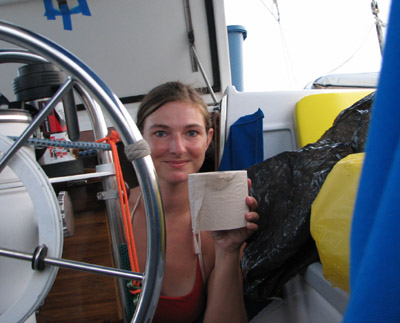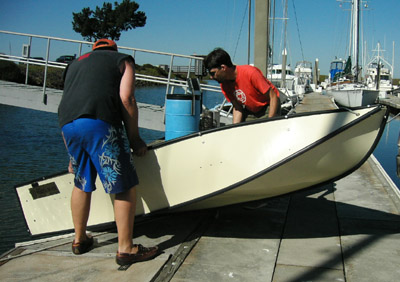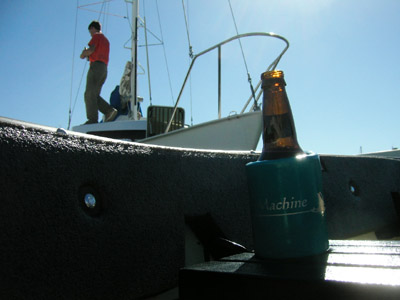1.3-Year Porta-Bote and Kayak Review
Wednesday, January 17th, 2007When we set out from Coyote Point, we had not one, but two dinghies aboard. (Mighty elaborate for a little 5000-pound boat.) We still have the two of them but neither is performing up to spec exactly and we are starting to think about how they might be more appropriately replaced, er, repaired. Or something.

[Patches discussed below are visible in this photo; there is another smaller patch on the other side in addition to a patched patch under the large panel patch.]
Dinghy #1 is the kayak, the inflatable two-person yellow kayak whose initial yellowness was so extreme that I was forced to squint my eyes and view the thing through the haze of my own eyelashes lest I damage the very cones of my retina and see nothing but purple the rest of my life. Joshua named it “Tigralita” after some tasty shrimp-like critters we used to eat in Barcelona, but we usually just call it The Kayak (or The Yellow). These days the kayak is not so yellow, rather, a pale misty cream dusted with sand and dotted with mud and cut with large swaths of silver-blue Cordura, which we use when we have to patch the thing. We’ve patched it now three times, the last patch basically replaced 50% of one entire side and it ripped out again the other day and needs yet another patch. Currently it is lying deflated and growing mildew in our port ama.
All this patching is getting to be a fat hassle. Basically, the protective sheathing around the inflatable tube is made from Cordura, a material that is not UV-resistant. Breaks down. Turns to crapola. So, every stress point on the top of the kayak (where the handles are attached, where the cargo D-rings are attached, etc.) is in danger of failing at any moment—that is, those that have not already. Irritatingly, the only light colored material we have lying about the boat for repairs is more Cordura so we get to gripe as we replace sections one by one with more UV-weak material. In addition to breaking down rapidly in UV, the color fades just as fast (as I mentioned above). This is hardly a problem for me since as far as I’m concerned, the less yellow and ratty looking, the better—provided that functionality is not compromised. Also, there’s a tiny hole in my inflatable seat lifter that leaves me sitting low after an hour or so. I remedy this by using an additional cushion so no biggie really.
I guess the good thing is that for an inflatable kayak, it is still kicking, somewhat. Once we patch it yet again, that is. Clearly the manufacturer of this kayak expected it to be used once or twice per year at most. A more appropriate material for repairs might be a light-color Sunbrella (dark colors are too hot and cause the innertubes to swell dangerously) and we will probably pick some up someplace to make additional repairs, thereby introducing yet a third weird pastel into the works. Other than the Cordura, the kayak is holding up fairly well, particularly the bottom, which is made of PVC. The clear PVC panels are still transparent but I have to say they never really worked very well because they warp the image on the bottom. I appreciate the gesture, but oh well. We might look into buying a rotomolded two-person kayak, which wouldn’t deflate and put away, but it would be a hell of a lot more tough.
Dinghy #2 is the Porta-bote, or ‘Bote’ as we generally call it. When we took off we had Joshua’s dad aboard for the initial run and we it was clear that a two-person inflatable “dinghy” was not exactly going to cut it. The bote is the 10-foot model and I bought the demo model from the Mountain View warehouse. We have used both dinghies about equal time on this trip; the bote is used when we have guests or when we are in ports where we need to tie up at some scrungy dock. So, this porta-bote has gotten its fair share of abuse I should say.
How it’s held up: Not too great but it still works, technically. We mentioned earlier in the blog how we busted the transom, and in addition, the middle and aft seats have split. Honestly I don’t know how we did that, these just split over time after usual wear and tear. Now, with the transom cracked almost in half (it sits in its place at a strange angle but still sort of helps reinforce the aft area) and the two after seats cracked in the middle, the boat is somewhat less stable than it used to be and there is no way a motor could be used anymore (we’ve used a motor on the dinghy only the time we were in Bahia del Sol to combat the 6-knot tides so it’s not like we’re devastated but just the thought that we couldn’t motor if we wanted is irritating).
Since we haven’t been motoring, what we have been doing is rowing. There’s a whole bucket of wormy gripes: the bote, although it rows admirably, has a built-in rowing setup with oars that is in general kind of crappy. The oars are cheap aluminum with a flat plastic spade on the end; conversely, they are lightweight and come apart in the middle. However, the place where they come apart makes the oars sort of wiggle in the middle. (Layer upon layer of trade-offs!) So, to lock the oars into the rowing position, an aluminum box is riveted to the sides of the hull and the oars have a pin that fits down into the box. This works okay if you row in placid water but if you have to really pull against a stiff wind, the oarlocks seem suddenly very flimsy. We popped a rivet only the third time we used the bote when we had to row against a wind in Bahia San Quentin on the outer Baja. Eventually the holes in the oar boxes wore wider and wider with the oar-peg action until the oar pegs pretty much swam around in the oar boxes (this had the gross side effect of oozing black sludgy oxidation all down the insides of the bote). Finally the oar-pegs just failed where they attached to the oars and we replaced them with standard ring-style oarlocks. Yesterday when we were rowing back to the boat, one of the oars just broke in half (not at the joint either, but halfway between the joint and the end—just ripped apart). Jeff ought to be happy to hear this as he was always highly skeptical of those funky oars. We’re currently faced with the quandary of whether to replace the oars altogether or try to fix the one; it’s probably only a matter of time before the second oar rips in half.
Another gripe about the bote is the flotation foam around the inside of the boat. Porta-bote boasts the virtual unsinkability of this bote due to flotation provided by a strip of raw black styrofoamy closed-cell foam that runs around the inside perimeter of the boat and the sealed bulky seats and transom. Well, now that the transom and the two larger of the seats are busted, they hold water better than they repel it so that leaves only the foam. Which is not UV-resistant. How much of a leap is it to realize that a boat might actually be out in the sun and plan construction materials accordingly? All Porta-bote has to do is coat them in some UV-resistant vinyl or something and they would be fine (I know this stuff exists and works because it is what covers our closed-cell foam cockpit cushions and they have been out in the sun for two years now and they still look brand new—disclaimer on the link: we would say this even if we weren’t related to the owners). So, basically, the foam is breaking down all over the place and there are little bits of crumbly black stuff all over the inside of the boat or you if you happen to brush up against the foam. We should just rip it out I guess and hope we don’t sink again. OH, and the flotation aspect? We did swamp our bote once (when we broke the transom) and while I wouldn’t say that it floated, I want to stress the “virtual” part of virtually unsinkable; we were able to get back to shore by getting out and guiding it (underwater) to shore.
The gunwale of the bote has a black plastic protective covering. In older models, it has a tendency to pop off but in our model, it has actually been riveted in place. Unfortunately, the rivets used are large and aluminum and scratch the hell out of anything they come up against (like the side of the mothership when tied alongside). We bought a length of clear plastic hose, sliced it lengthwise and wrapped it around the black plastic. This helps but we have to babysit it to keep it from popping off.
One last thing: the seats and transom are made of black plastic and they COOK when in the sun for even just a few minutes. They are frequently excruciatingly painful to sit upon and I never seem to remember to bring a towel or something to cover them with. Most people we have met who have Porta-botes have replaced the seats and transom entirely with lower profile ones made of wood and painted white. I highly recommend doing this and I wish we had done ours as well back in Bahia del Sol. One boat we met also covered his foam with a cheerful stripey Sunbrella and this kept the crumbling at bay somewhat.
Someone commented recently that we should contact Porta-bote to see if perhaps the transom (or seats) was covered by warranty since a lot of people have reported transom failure and so we emailed them a couple weeks ago. I sort of waited on posting this dinghy-review post because we wanted to be able to include information about whether Porta-bote indeed covered damages to the transom or not but they still haven’t gotten back to us and I’m not optimistic that they ever will. I know the email address is viable too because we used it when we had a motor question (like, we were interested in buying a motor) and we had a cheerful response in less than a day. Sooo… that’s sort of irritating, especially since all she has to do is just say “No, we don’t cover the transom under warranty,” and that would be that. As it is, I feel like they are deliberately ignoring us. Another sort of weird thing is when we talked to other Porta-bote owners in Bahia del Sol (there were five botes there at one time), every one of them had had the same issues and they had been reporting back to Porta-bote with some impression that their feedback was appreciated and the issues were being worked on or fixed. However, our bote was new and none of the common complaints had been addressed.

[The putting away of the bote. See how flat? The bulky seats are another story but we just stuff them down in the ama.]
Anyway, that all said, maybe the bote model after ours has all the problems fixed and somehow our recent email got lost in the ether. I don’t know. I’m a little irritated with all this but then there are some really great things about the bote that have been perfect for us. It folds up. When we put it away, we just strap it down underneath the catwalk and it all but disappears! Amazing. It takes maybe ten minutes to take apart and stow entirely. And the plastic material that the hull is made of is very strong; we drag it over sand and rocks and tie it up at rusting charred docks where it bangs around and the outer hull is holding up just fine (it shows all the scratches, but that’s fine). The bote is not something desirable to thieves either. That’s because it’s so ugly! Most of the locals view the bote with extreme amusement and incredulity that it is even vaguely seaworthy. (Don’t even get me started at the reactions we get when they see me rowing it—and Joshua relaxing on the stern.)
One other thing I should mention: “used porta-bote” is the single most common search request that leads people to this blog, so these boats are definitely sought after. Used ones in particular since new ones are very pricey.
To sum up: Kayak—we are seriously considering upgrading to a hard kayak (two person kayaks are so damned big though). I do like having it deflate and go away. Bote—so many problems that could so easily be remedied by Porta-bote, such as installing a UV-resistant foam if they actually intend this to be used for safety purposes. That the botes are so very expensive makes me think that it’s within the budget but what do I know. I still like the bote, but it just needs work. We need to replace the seats and transom entirely with something more durable (wood) and light in color and the foam needs to be removed or replaced. CCushions said that Porta-bote contacted them about making a closed-cell vinyl-coated foam for them but it was too expensive, yet we might end up replacing it with C-Cushion on our own anyway. Also, the rowing situation…yeesh; I’ll just stop now.
UPDATE:
Porta-bote did eventually replace the seats and transom for free. Here is a quick round up of follow up posts.









